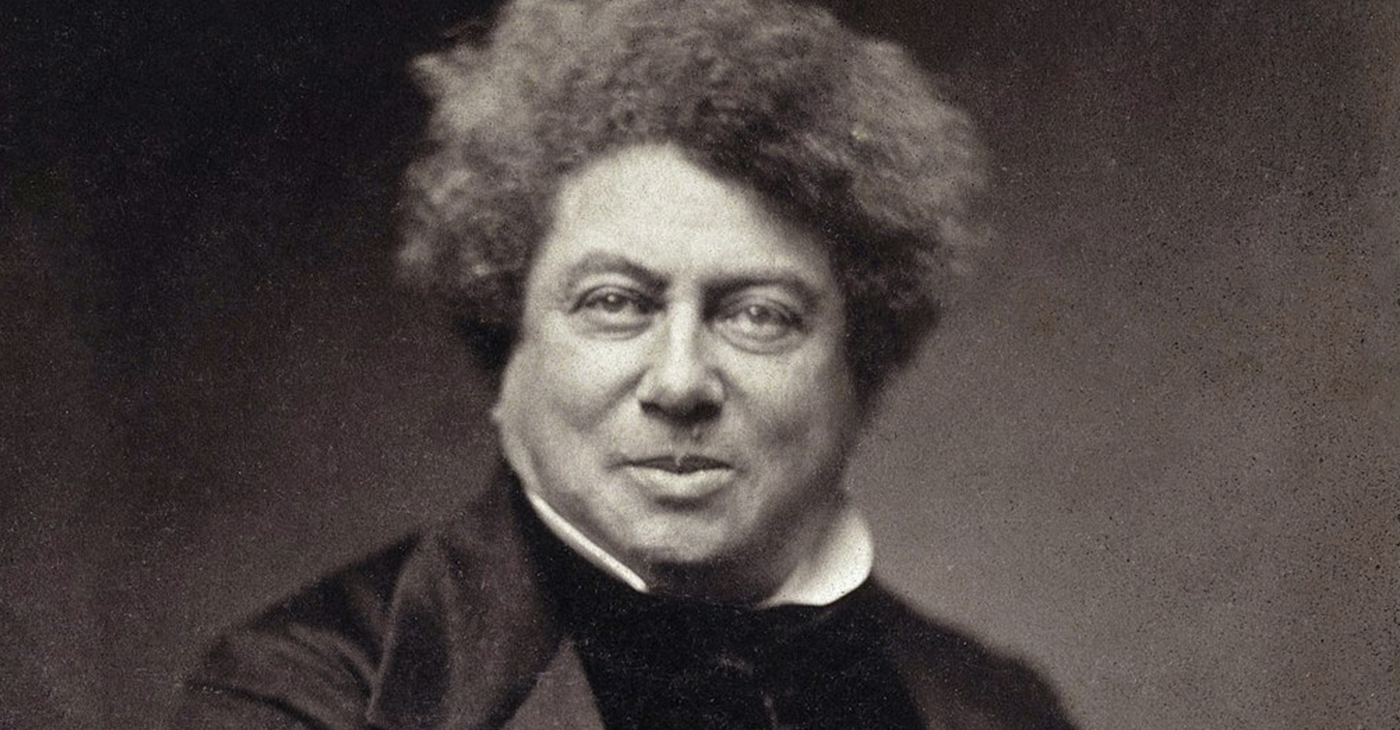Black History
Alexandre Dumas: The French Author of ‘The Three Musketeers’
Alexandre Dumas wrote plays, both comedies and dramas. Scholars describe his writing as having a “heavy emphasis on plot; his primary skill as a writer consisted of his capacity to imagine and execute tales of breathtaking adventures that cause the reader to experience feelings of excitement.”

By Tamara Shiloh
Best known for having penned the historical adventure novels “The Three Musketeers” (1844) and “The Count of Monte Cristo,” (1846) Alexandre Dumas (1802–1870) established himself as one of the most popular and prolific authors in France.
He wrote essays, short stories, volumes of romantic novels, plays, and travelogues, many having been translated into more than 100 languages and adapted for numerous films. But Dumas’ own story begins with his father, Thomas-Alexandre Davy de la Pailleterie.
Thomas-Alexandre adopted the Dumas name from his Haitian grandmother. He did so just prior to enlisting in Napoleon Bonaparte’s army. He rose to the rank of general, the highest rank of any Black man in a European army. He would separate from the military after clashing with Bonaparte over his Egyptian Campaign.
The elder Dumas left Egypt in 1799 traveling on what was known to be an unsound vessel. The ship’s troubles forced it to put aground in Naples, a city in southern Italy. There Thomas-Alexandre Dumas was arrested, thrown into a dungeon, and held for two years.
After his release, he returned to France. The following year, Alexandre was born. Thomas-Alexandre died when his son was four.
Dumas’ mother, Marie Louise Labouret, took on several jobs to ensure that her son was educated. He attended Abbé Grégoire’s school, but later quit to take a job assisting a local notary.
He held such a great interest in reading and books that he relocated to Paris at age 20 to immerse himself in literature. There he met the duc d’Orléans (later named King Louis Philippe) and began working for him as a scribe. It was then that Dumas dreamed of publishing his own works.
He wrote plays, both comedies and dramas. Scholars describe his writing as having a “heavy emphasis on plot; his primary skill as a writer consisted of his capacity to imagine and execute tales of breathtaking adventures that cause the reader to experience feelings of excitement.”
Dumas’ style is often compared to that of his contemporary and rival Victor Hugo.
It is estimated that all his published writings, if placed in one document, would span about 100,000 pages.
Dumas did well financially, but his spending rivaled his earnings. He spent much of his life in debt because of his extravagant lifestyle. He built a home in the country himself (now a museum), but after two years of lavish living, financial difficulties forced him to sell it. Another downfall was that he kept several mistresses.
Dumas married actress Ida Ferrier (1840) yet continued to have relationships with other women. According to scholar Claude Schopp, Dumas entertained about 40 women and fathered at least four children outside of the marriage.
To escape creditors, Dumas fled to Belgium, then to Russia. Still, he published his work, including travel books on Russia. He continued to take on mistresses, including much younger women in his old age. He remained married to Ferrier until his death in 1870.
Suggested reading: “Alexandre Dumas: Genius of Life,” by Claude Schopp.
Activism
Oakland Post: Week of April 24 – 30, 2024
The printed Weekly Edition of the Oakland Post: Week of April 24 – 30, 2024

To enlarge your view of this issue, use the slider, magnifying glass icon or full page icon in the lower right corner of the browser window. ![]()
Activism
Oakland Post: Week of April 17 – 23, 2024
The printed Weekly Edition of the Oakland Post: Week of April 17 – 23, 2024

To enlarge your view of this issue, use the slider, magnifying glass icon or full page icon in the lower right corner of the browser window. ![]()
Black History
Matthew Henson: Explorer Extraordinaire
Matthew Henson, a trailblazing explorer who overcame countless obstacles to leave an incredible mark on history. Born on August 8, 1866, in Charles County, Maryland, his journey is a testament to the power of determination and the spirit of adventure.

By Tamara Shiloh
Matthew Henson, a trailblazing explorer who overcame countless obstacles to leave an incredible mark on history. Born on August 8, 1866, in Charles County, Maryland, his journey is a testament to the power of determination and the spirit of adventure.
Henson’s life began amidst the backdrop of post-Civil War America, where opportunities for African Americans were scarce. From a young age, he possessed an insatiable curiosity about the world beyond his small town. At the age of 12, he embarked on a journey that would change the course of his life forever when he joined a merchant ship as a cabin boy.
His most famous expedition was his journey to the Arctic with renowned explorer Robert E. Peary. In 1887, Henson joined Peary’s crew as a seaman and quickly proved himself to be invaluable with his skills as a navigator and craftsman. Over the course of several expeditions, Matthew endured extreme cold, treacherous terrain, and grueling conditions as he and Peary sought to reach the elusive North Pole.
In 1908–09, Peary set out on his eighth attempt to reach the North Pole. It was a big expedition, with Peary planning to leave supplies along the way. When he and Henson boarded their ship, the Roosevelt, leaving Greenland on August 18, 1909, they were joined by a large group. This included 22 Inuit men, 17 Inuit women, 10 children, 246 dogs, 70 tons of whale meat, blubber from 50 walruses, hunting gear, and tons of coal.
In February, Henson and Peary left their anchored ship at Ellesmere Island’s Cape Sheridan, along with the Inuit men and 130 dogs. They worked together to set up a trail and supplies along the way to the Pole.
Peary picked Henson and four Inuit people to join him in the final push to the Pole. However, before they reached their destination, Peary couldn’t walk anymore and had to ride in a dog sled. He sent Henson ahead to scout the way. In a later interview with a newspaper, Henson recalled being in the lead and realizing they had gone too far. The group turned back, and Henson noticed his footprints helped guide them to their destination. At that location, Henson planted the American flag.
Henson’s legacy extends far beyond his expeditions to the Arctic. He shattered racial barriers in the world of exploration and inspired countless individuals, regardless of race, to dream big and pursue their passions. In 1937, he was finally recognized for his achievements when he was inducted into The Explorers Club, an organization dedicated to promoting scientific exploration and field research.
Matthew Henson died in the Bronx, New York, on March 9, 1955, at the age of 88.
-

 Community2 weeks ago
Community2 weeks agoFinancial Assistance Bill for Descendants of Enslaved Persons to Help Them Purchase, Own, or Maintain a Home
-

 Activism3 weeks ago
Activism3 weeks agoOakland Post: Week of April 3 – 6, 2024
-

 Business2 weeks ago
Business2 weeks agoV.P. Kamala Harris: Americans With Criminal Records Will Soon Be Eligible for SBA Loans
-

 Community2 weeks ago
Community2 weeks agoAG Bonta Says Oakland School Leaders Should Comply with State Laws to Avoid ‘Disparate Harm’ When Closing or Merging Schools
-

 Activism2 weeks ago
Activism2 weeks agoOakland Post: Week of April 10 – 16, 2024
-

 Community1 week ago
Community1 week agoOakland WNBA Player to be Inducted Into Hall of Fame
-

 Community1 week ago
Community1 week agoRichmond Nonprofit Helps Ex-Felons Get Back on Their Feet
-

 City Government2 weeks ago
City Government2 weeks agoLAO Releases Report on Racial and Ethnic Disparities in California Child Welfare System
























































